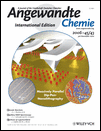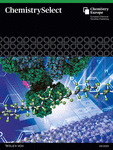Journal list menu
Export Citations
Download PDFs
Cover Picture
Cover Picture: Massively Parallel Dip–Pen Nanolithography with 55 000-Pen Two-Dimensional Arrays (Angew. Chem. Int. Ed. 43/2006)
- Page: 7099
- First Published: 30 October 2006
Massively parallel dip–pen nanolithography is possible when 55 000 AFM cantilevers are used to write molecules directly onto a surface. An optical micrograph shows the surface after etching (cover picture, left), and each round feature is a miniature image of the face of Thomas Jefferson (AFM image, right), who helped develop the polygraph, a duplicator based on an array of pens. For more information on the new technique see the Communication by C. A. Mirkin and co-workers on page 7220 ff.
Graphical Abstract
Graphical Abstract: Angew. Chem. Int. Ed. 43/2006
- Pages: 7102-7112
- First Published: 30 October 2006
Web Site
Book Reviews
Organic Light-Emitting Devices. Synthesis, Properties and Applications. Edited by Klaus Müllen and Ullrich Scherf.
- Pages: 7115-7116
- First Published: 30 October 2006
The Nanotech Pioneers. Where Are They Taking Us? By Steven A. Edwards.
- Pages: 7116-7117
- First Published: 30 October 2006
Highlight
The Twisted Amide 2-Quinuclidone: 60 Years in the Making†
- Pages: 7118-7120
- First Published: 30 October 2006
Minireview
Extending the Scope of NMR Spectroscopy with Microcoil Probes†
- Pages: 7122-7131
- First Published: 30 October 2006

. ‥ and to cap it off: Capillary NMR (CapNMR) spectroscopy is emerging as a major breakthrough in increasing the mass-sensitivity of NMR spectroscopic analysis. As discussed in the Minireview, not only is the acquisition of the spectra of mass-limited samples getting easier but the quality of CapNMR spectra obtained in many small-molecule applications exceeds what can be accomplished with conventional probe designs.
Review
Communications
Tissue Imaging at Atmospheric Pressure Using Desorption Electrospray Ionization (DESI) Mass Spectrometry†
- Pages: 7188-7192
- First Published: 30 October 2006

Images of the masses: Two-dimensional molecular imaging of intact rat brain tissue under ambient conditions was achieved by using the mass spectrometric technique of desorption electrospray ionization (DESI). The distributions of specific lipids, such as sulfatide 24:1, reveal distinctive subanatomical features of the rat brain (cc=corpus callosum; aca=anterior part of anterior commissure) with spatial resolution of less than 500 μm.
A Manganese(III) Complex That Exhibits Spin Crossover Triggered by Geometric Tuning†
- Pages: 7192-7195
- First Published: 30 October 2006

Room to expand: A rare example of thermal spin crossover in a MnIII complex is accompanied by elongation of the bonds to the equatorial N4 donor set upon warming (see scheme; Mn purple, N blue, O red), which is consistent with population of the d orbital. The spin crossover was observed for an N4(O−)2 donor set with axial oxygen donors, whereas only a temperature-independent high-spin state was observed with these donors in a cis arrangement.
orbital. The spin crossover was observed for an N4(O−)2 donor set with axial oxygen donors, whereas only a temperature-independent high-spin state was observed with these donors in a cis arrangement.
Nanofibers with Tunable Stiffness from Self-Assembly of an Amphiphilic Wedge–Coil Molecule†
- Pages: 7195-7198
- First Published: 30 October 2006

Thin end of the wedge: A block molecule, which consists of a rigid wedge-shaped aromatic segment linked at its apex to a flexible poly(ethylene oxide) chain, self-assembles into cylindrical nanofibers in both polar and nonpolar solvents. The structure of the nanofibers changes reversibly in response to solvent polarity, from highly flexible coil-like cylinders in water to stiff rodlike aggregates in n-hexane (see picture).
The Changing Faces of Halogenated Marine Natural Products: Total Synthesis of the Reported Structures of Elatenyne and an Enyne from Laurencia majuscula†
- Pages: 7199-7202
- First Published: 30 October 2006

Knocking them into shape: The total synthesis of two reported marine natural products containing halogenated pyrano[3,2-b]pyrans (see example in blue) has led to the reassignment of both structures as halogenated 2,2′-bifuranyls (red). Concomitantly an efficient route to pyrano[3,2-b]pyrans is described.
Optical Sensors Based on Nanostructured Cage Materials for the Detection of Toxic Metal Ions†
- Pages: 7202-7208
- First Published: 30 October 2006

Seeing red: Highly sensitive and selective chemical sensing systems were developed for the naked-eye detection of toxic ions by the direct and indirect postgrafting of hydrophilic and hydrophobic chromophores into spherically nanosized cavities of cubic Fm3m monoliths (HOM-C10). This leads to reliable control over the visual detection of toxic metals such as PbII, CdII, SbIII, and HgII ions at a low concentrations (≈10−9 M). DZ= diphenylthiocarbazone.
Corannulene “Hub” Carbon Coordination by [Ru2{O2C(3,5-CF3)2C6H3}2(CO)5]†
- Pages: 7208-7210
- First Published: 30 October 2006
![Corannulene “Hub” Carbon Coordination by [Ru2{O2C(3,5-CF3)2C6H3}2(CO)5]](/cms/asset/37dc8ad9-b2c4-4c8f-9322-dcbf744abfe5/mcontent.jpg)
Right to the core: A ruthenium(I) complex of corannulene, prepared in a solvent-free environment, exhibits two coordination modes of the bowl: η2-rim and η1-hub (see picture for the hub-coordinated complex; Ru purple, O red, C gray, H white). The latter represents the first example of a transition-metal center binding only to the fullerene-like interior of an open geodesic polyarene.
Noncrystalline Metal–Boron Nanotubes: Synthesis, Characterization, and Catalytic-Hydrogenation Properties†
- Pages: 7211-7214
- First Published: 30 October 2006

It's all in the mix: A mixed-surfactant-templated synthesis gives noncrystalline metal–boron nanotubes (see picture: TEM image of Fe–B nanotubes; inset: the corresponding selected-area electron diffraction pattern) from simple starting materials under mild conditions. These nanotubes show better catalytic activity for the hydrogenation of m-nitrotoluene to m-toluidine than the corresponding nanoparticles.
Halogen-Bridged PtII/PtIV Mixed-Valence Ladder Compounds†
- Pages: 7214-7217
- First Published: 30 October 2006

Chutes and …︁ Ladders in coordination networks represent a boundary between 1D and 2D systems. Halogen-bridged PtII/PtIV mixed-valence ladder compounds have been synthesized for the first time. In these compounds, the band gap is controlled by changing the bridging halide ions. Moreover, by changing counteranions, the charge arrangements of the ladder compounds can be controlled.
A Heterogeneous Silica-Supported Scandium/Ionic Liquid Catalyst System for Organic Reactions in Water†
- Pages: 7217-7220
- First Published: 30 October 2006
Massively Parallel Dip–Pen Nanolithography with 55 000-Pen Two-Dimensional Arrays†
- Pages: 7220-7223
- First Published: 30 October 2006

Lots of writing on the wall: A simple and flexible approach for performing high-throughput, large-area, direct-write molecular patterning, without tip feedback, is demonstrated by using a 55 000-pen two-dimensional array of atomic force microscope (AFM) cantilevers. The use of low-aspect-ratio pyramidal tips, curved cantilevers, and a novel gravity-driven alignment method allows parallel patterning of molecules across 1-cm2 substrate areas at sub-100-nm resolution.
Photochemical Synthesis of R-Shaped DNA toward DNA Recombination and Processing In Vitro†
- Pages: 7223-7226
- First Published: 30 October 2006

Rewriting the end: Two unmodified oligodeoxyribonucleotides (ODNs) were photochemically ligated through modification of ODNs that contain photosensitive nucleosides at both terminal ends in the presence of a template ODN. Additionally, this method was applied to the synthesis of R-shaped DNA as a unique structure.
Dynamic Motion of Building Blocks in Porous Coordination Polymers†
- Pages: 7226-7230
- First Published: 30 October 2006

Controlling guests: Porous coordination polymers containing mobile organic groups, such as naphthalene rings (see picture), are synthesized, and their rotational motion is characterized by solid-state 2H NMR spectroscopy. The rotation of the groups can be switched off (blue) by guest (blue spheres) adsorption and switched on (yellow) again by guest desorption.
A Highly Efficient and Practical Method for Catalytic Asymmetric Vinylogous Mannich (AVM) Reactions†
- Pages: 7230-7233
- First Published: 30 October 2006

Very selective but very easy: These are two of the attributes of the asymmetric vinylogous Mannich reactions presented herein. These reactions can be run on a gram scale and in undistilled THF and air (see scheme; TMS=SiMe3). All that is needed is commercially available AgOAc, a readily available amino acid derived phosphine, and a commercially available or easily prepared (one step) siloxyfuran.
Na2Li8[(UO2)11O12(WO5)2]: Three Different Uranyl-Ion Coordination Geometries and Cation–Cation Interactions†
- Pages: 7233-7235
- First Published: 30 October 2006
![Na2Li8[(UO2)11O12(WO5)2]: Three Different Uranyl-Ion Coordination Geometries and Cation–Cation Interactions](/cms/asset/55e3963a-0864-4b80-bd3c-94d8b4376ae3/mcontent.jpg)
Uranyl interactions: The title compound is the first example of an actinide compound that contains three different actinyl-ion coordination geometries, namely, octahedral, pentagonal bipyramidal, and hexagonal bipyramidal. Strong cation–cation interactions between the uranyl ions lead to pentamers with a rather unusual configuration (see picture; U dark gray, O light gray).
Total Synthesis of Tubulysin U and V†
- Pages: 7235-7239
- First Published: 30 October 2006

Multicomponent method: Tubulysins are among the most potent cytotoxic agents known. Now the first total synthesis of some members has been achieved by utilizing a rapid three-component reaction for the synthesis of the unusual central thiazole amino acid tubuvaline (see scheme; Boc=tert-butoxycarbonyl, Ac=acetyl), thereby opening new perspectives for anticancer drug development.
Bioenabled Synthesis of Rutile (TiO2) at Ambient Temperature and Neutral pH†
- Pages: 7239-7243
- First Published: 30 October 2006

Biomineral-forming organisms provide inspiration for developing new reaction pathways to functional materials, such as rutile for optical devices. A recombinant protein (rSilC) was designed based on the sequence of a silica-forming protein from a diatom. This unique protein induced the formation of hierarchically nanostructured rutile microcrystals under mild reaction conditions (see SEM image).
Hormone–PAMAM Dendrimer Conjugates: Polymer Dynamics and Tether Structure Affect Ligand Access to Receptors†
- Pages: 7243-7248
- First Published: 30 October 2006

An open and closed case: Estradiol was conjugated to a PAMAM dendrimer (gray circle) through a short (17α-phenylethynyl) or a long (hexaethyleneglycol) tether to evaluate how ligand access to a receptor is affected. With the short tether (a), the hormone is free and solvent exposed, with unimpeded access to the estrogen receptor, while the long tether (b) wraps around the hormone and the dendrimer and markedly reduces access to the receptor.
Taming a Functional Group: Creating Air-Stable, Chiral Primary Phosphanes†
- Pages: 7248-7251
- First Published: 30 October 2006

No rings of fire! Enantiopure primary phosphanes have been developed which are remarkably stable to air oxidation in both solid and solution states (see example). This new class of stable ligand synthon appears to owe its stability to conjugation in their aryl backbones with the extended π ring system. Even one extra ring is good enough.
On the Species Involved in the Vaporization of Imidazolium Ionic Liquids in a Steam-Distillation-Like Process†
- Pages: 7251-7254
- First Published: 30 October 2006
An Engineered Linker Capable of Promoting On-Resin Reactions for Microwave-Assisted Solid-Phase Organic Synthesis†
- Pages: 7255-7258
- First Published: 30 October 2006

An active link: A diglycine-containing linker (cat⋅linker) was fabricated on Rink amide resin for dual functions: a) attachment of a scaffold and b) capture of metal ions for promoting on-resin reactions (see picture). The metal-catching feature of the linker proves essential for the solid-phase synthesis of indoles through microwave-assisted CuII-mediated heteroannulation.
Synthesis of the C31–C67 Fragment of Amphidinol 3†
- Pages: 7258-7262
- First Published: 30 October 2006
Polyazidopyrimidines: High-Energy Compounds and Precursors to Carbon Nanotubes†
- Pages: 7262-7265
- First Published: 30 October 2006

An additional azidomethyl group dramatically decreases the melting points of the corresponding azidopyrimidines. Theoretical calculations show that these polyazido compounds (see picture; N light blue, C dark blue, H white) exhibit highly promising energetic properties. 2,4,6-Triazidopyrimidine was found to be a novel precursor to carbon nanotubes in the presence of Ni(ClO4)2.
Crystallographic Characterization of Difluoropropargyl Indium Bromide, a Reactive Fluoroorganometallic Reagent†
- Pages: 7265-7267
- First Published: 30 October 2006

Elusive intermediate trapped: γ-Substituted difluoropropargyl groups can stabilize an organoindium(III) complex. The resulting structure is the only known example of an indium atom bonded to a propargylic carbon atom (see picture; F blue, S yellow, C white, H green). Reactions with electrophiles produced a difluoroalkyne or -allene, depending on the type of electrophile.
Towards Homoleptic Naphthalenemetalates of the Later Transition Metals: Isolation and Characterization of Naphthalenecobaltates(1−)†
- Pages: 7268-7271
- First Published: 30 October 2006

Taming of the wild anions: Highly labile naphthalene complexes of formally negative-valent later transition metals have been obtained in the form of [Co(η4-C10H8)(η4-cod)]− (see picture; cod=1,5-cyclooctadiene) and [Co(η4-C10H8)2]−. The latter is the first structurally authenticated homoleptic bis(naphthalene)metal anion for any d-block element and promises to be a particularly reactive synthon for the “naked” atomic cobalt anion.
Ambient-Temperature Living Anionic Polymerization of Phosphaalkenes: Homopolymers and Block Copolymers with Controlled Chain Lengths†
- Pages: 7271-7274
- First Published: 30 October 2006

New kid on the block: Unprecedented polystyrene-block-poly(methylenephosphine) copolymers are accessible from the reaction of living polystyrene with the phosphaalkene (see scheme; Mes=2,4,6-Me3C6H2). The living anionic polymerization of PC bonds represents a new development in phosphorus chemistry and opens up the possibility to synthesize functional phosphorus polymers of controlled architectures.
Selective Formation of Polycarbonate over Cyclic Carbonate: Copolymerization of Epoxides with Carbon Dioxide Catalyzed by a Cobalt(III) Complex with a Piperidinium End-Capping Arm†
- Pages: 7274-7277
- First Published: 30 October 2006

Sidestepping a cyclic side product: Copolymerization of terminal epoxides with CO2 was investigated by using a cobalt(III) complex bearing a piperidinium end-capping arm and a piperidinyl arm (see scheme; DME=1,2-dimethoxyethane). The catalyst system can selectively produce copolymers without contaminant formation of cyclic carbonates even at high conversion of the epoxide (>99 %).
Efficient Preparation and Catalytic Activity of MgO(111) Nanosheets†
- Pages: 7277-7281
- First Published: 30 October 2006

Preferential growth of MgO(111) nanosheets with a thickness typically between 3 and 5 nm (see TEM image) has been achieved by a simple, efficient, and inexpensive wet chemical route. The MgO(111) nanosheets have been shown to have ultrahigh activity for the Claisen–Schmidt condensation of benzaldehyde and acetophenone.
NMR Spectroscopy of Laser-Polarized 129Xe Under Continuous Flow: A Method To Study Aqueous Solutions of Biomolecules†
- Pages: 7282-7284
- First Published: 30 October 2006

Go with the flow: In many applications of NMR spectroscopy in chemistry, proper sample preparation is absolutely critical for success, in particular in biochemical and biomedical areas. For the NMR spectroscopy of laser-polarized 129Xe, an efficient and robust method for continuous flow of the gas to a NMR tube was developed. Applications to H2O, DMSO, phospholipid bicelles, and 2D exchange NMR spectroscopy are demonstrated.
Cycloisomerization of 1,6-Dienes Mediated by Lewis Super Acids without Additives: Easy Access to Polysubstituted Six-Membered Carbocycles
- Pages: 7285-7289
- First Published: 30 October 2006

The tin salt Sn(NTf2)4 (Tf=trifluoromethanesulfonyl) is an efficient catalyst for the selective and ring-size-specific cycloisomerization of highly substituted 1,6-dienes to give six-membered-ring carbocycles (see scheme; X=C(CO2Et)2, C(CO2Me)2 C(CN)(CO2Et), etc.). This is the first Lewis acid catalyzed cycloisomerization of this type of substrate.
Aqueous-Phase Hydroformylation of 1-Octene: Styrene Latices as Phase-Transfer Agents†
- Pages: 7289-7292
- First Published: 30 October 2006

An elegant method for the aqueous-phase hydroformylation of 1-octene with a water-soluble Rh catalyst and amphiphilic latex particles as phase-transfer agents has been developed (see scheme). In this way, substantial concentrations of the olefin in the aqueous catalyst-containing phase were reached, and thus reasonable turnover frequencies under mild reaction conditions could be achieved.
Proton Magnetic Shielding Tensors in Benzene—From the Individual Molecule to the Crystal†
- Pages: 7292-7295
- First Published: 30 October 2006

Inequivalent in the crystal: The three chemically distinct calculated proton shielding tensors of solid benzene—a consequence of interactions in the crystal—can be described as the superposition of the isolated molecule and the intermolecular shielding contributions. In the ovaloid representations of the shielding tensors 1, 2, and 3 indicate the least, intermediate, and most shielded principal axes, respectively.
Bridging Rotaxanes' Wheels—Cyclochiral Bonnanes†
- Pages: 7296-7299
- First Published: 30 October 2006













































